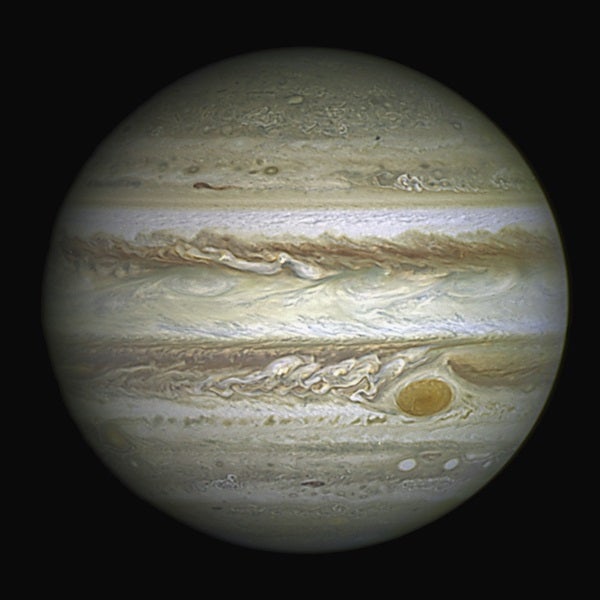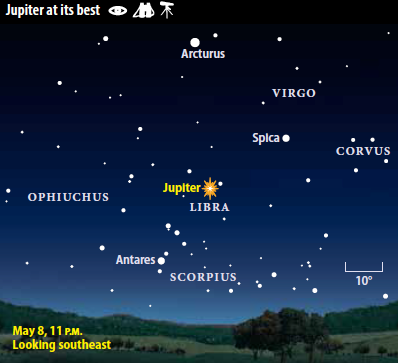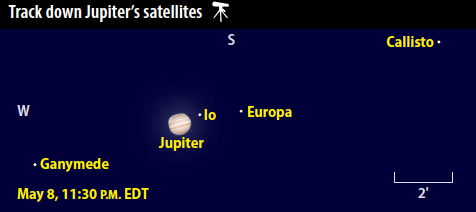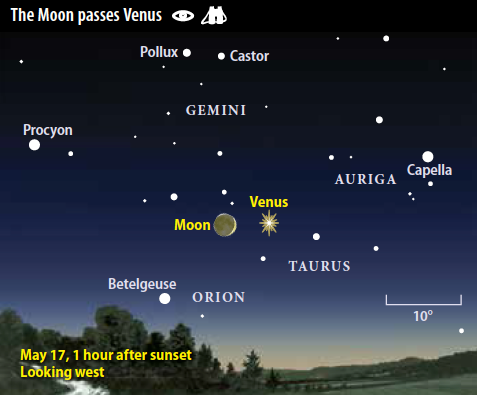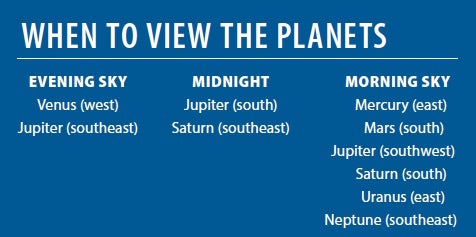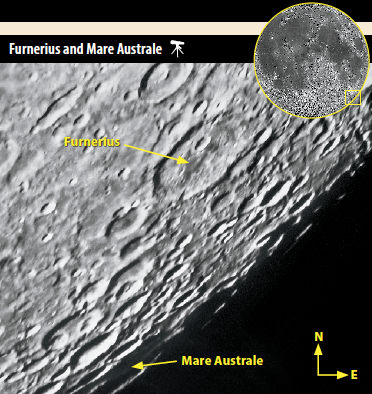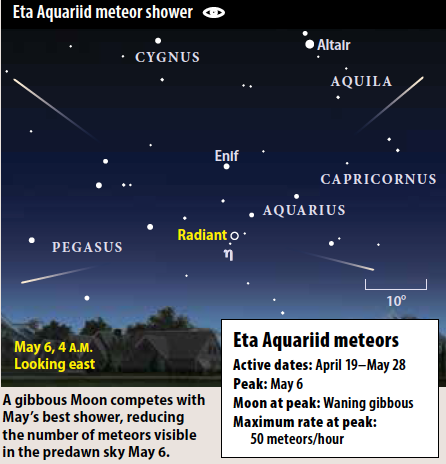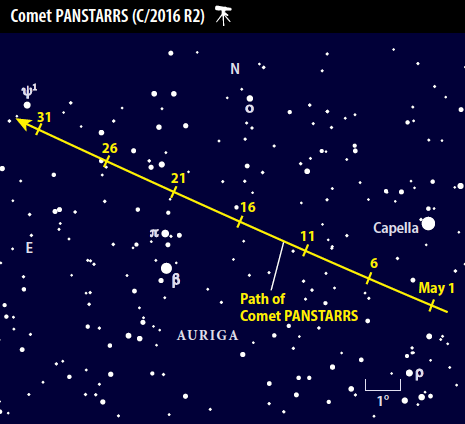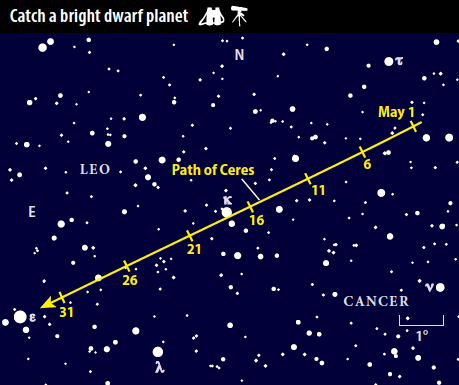Let’s start our tour in the western sky shortly after sunset. Venus shines at magnitude –3.9 and appears beautiful against the backdrop of bright stars typically associated with winter. On May 1, the planet lies in Taurus about 5° north of the Hyades star cluster and 10° east of the Pleiades (M45). The stars of Orion add to the stunning scene as they sink toward the western horizon along with Venus.
Venus treks eastward as May progresses, arriving at a point midway between the Bull’s horns (Beta [β] and Zeta [ζ] Tauri) on the 13th. Four days later, a wafer-thin crescent Moon stands 6° to Venus’ left. Our satellite appears only 9 percent lit because it passed between the Sun and Earth just two days earlier. Venus, on the other hand, lies on the far side of its orbit, and a telescope reveals a 12″-diameter disk that is 84 percent lit.
Venus continues its eastward sojourn all month. It crosses into Gemini on May 19 and passes less than 1° north of the 5th-magnitude star cluster M35 on the 20th. By month’s end, the planet resides in central Gemini.
As twilight deepens, Jupiter appears low in the east. On May 1, it rises by 8:30 p.m. local daylight time and achieves the same altitude as Venus (though on the other side of the sky) around 9:20 p.m.
Jupiter reaches opposition May 8, when it lies opposite the Sun in our sky and remains visible all night. This peak coincides with the planet’s closest approach to Earth, so it shines brightest and appears largest through a telescope. But as an outer planet, Jupiter changes slowly — it shines brilliantly at magnitude –2.5 all month, and its equatorial diameter stays between 44″ and 45″.
The planet’s steady appearance is reflected in its slow motion across the sky. Jupiter resides in Libra, beginning May 4° east of Zubenelgenubi (Alpha [α] Librae) and ending the month 0.9° northeast of this 3rd-magnitude star.
Even the smallest instrument reveals Jupiter’s two dark equatorial belts, which sandwich a brighter zone that coincides with the planet’s equator. More details pop into view during moments of good seeing, when Earth’s atmosphere steadies, or when observing through larger scopes. Look for a series of alternating belts and zones that extends to the polar regions. Also focus on features along the turbulent edges of the dark belts.
Because the planet spins on its axis in less than 10 hours, its appearance changes noticeably in as little as 10 minutes. Combined with Jupiter’s gaseous nature, this rapid spin causes the world’s equatorial regions to bulge. Look carefully and you’ll notice that the diameter through the poles is 6 percent smaller than across its equator.
Small scopes also excel at showing Jupiter’s four bright moons. It can be a challenge to identify them, but the alignment on opposition night makes it easy. On the evening of May 8, Io, Europa, and Callisto line up in that order east of Jupiter while Ganymede is the lone moon west of the planet. With three satellites on one side and one on the other, you can quickly tell which direction is which — often a problem because the orientation of the field depends on the type of instrument you use and when you observe — and thus distinguish the moons.
Once each orbit, Io, Europa, and Ganymede transit Jupiter’s disk along with their shadows. Earlier this year, each moon’s shadow crossed before the moon itself. But around the time of opposition, when the Sun lies behind Earth as we look toward Jupiter, the moons and shadows practically overlap. On May 7, for example, Io’s shadow touches the jovian cloud tops at 10:56 p.m. EDT — just two minutes before Io itself. The moon and shadow both leave Jupiter’s disk at 1:06 a.m. Contrast this with the scene May 30, when Io transits starting at 10:37 p.m. but the shadow doesn’t hit the planet until 30 minutes later.
The ringed planet resides among the background stars of Sagittarius, just north of that constellation’s Teapot asterism. On May 1, it stands nearly 4° northeast of 3rd-magnitude Lambda (λ) Sagittarii, the star marking the top of the Teapot’s lid, and 1.7° north of the 5th-magnitude globular star cluster M22. Saturn moves slowly westward during May, ending the month 1.8° northwest of M22.
Saturn brightens from magnitude 0.3 to 0.2 during May. It far outshines Sagittarius’ stars, and its yellow glow makes it easy to identify. The planet will brighten a bit more, to magnitude 0.0, by opposition in late June.
Like Jupiter, Saturn’s appearance through a telescope doesn’t change much in May. But that’s a good thing, because few celestial objects rival the beautiful ringed world. In mid-May, the planet’s disk measures 18″ across while the rings span 40″ and tilt 26° to our line of sight. Even small scopes reveal the Cassini Division, a dark gap that separates the outer A ring from the brighter B ring. Small instruments also show Saturn’s brightest moon, 8th-magnitude Titan.
Although you won’t notice much change with Jupiter and Saturn this month, Mars improves dramatically. The Red Planet is just two months away from a late July opposition that will bring it closer to Earth than it has been in 15 years. Observers will notice a rapid buildup toward this peak in May — Mars doubles in brightness (from magnitude –0.4 to –1.2), and its angular diameter grows by a third (from 11″ to 15″).
Your best views through a telescope come shortly before twilight begins. By then, Mars has climbed about 25° high in the south-southeast. (It appears higher the farther south you live.) The planet’s visible hemisphere changes little from one night to the next because Mars rotates just a bit slower than Earth. If you observe the Red Planet at the same time each morning, the longitude at the center of the disk shifts only 9.1° each day.
For observers in North America on May’s first few mornings, the dark, wedge-shaped feature known as Syrtis Major stands at the center of the martian disk. A week later, the dark, fingerlike Mare Cimmerium takes center stage. The volcanic Tharsis region rotates into view on mornings in mid-May. And by the 21st and 22nd, Solis Lacus appears quite prominent.
The remaining planets cluster low in the east before sunrise. Neptune rises at the break of dawn in early May but becomes a much easier target late in the month. On the 31st, it rises around 2 a.m. local daylight time and climbs 20° high in the east-southeast as twilight commences. Glowing at magnitude 7.9, it’s an easy binocular object set against the backdrop of Aquarius. Look for it 1.0° west of 4th-magnitude Phi (ϕ) Aquarii.
Uranus pops into view at the end of May. After a five-year stint among the background stars of Pisces, the distant planet now resides in Aries. You can find it through binoculars 10° due south of 3rd-magnitude Beta (β) Arietis and 3° northeast of 4th-magnitude Omicron (ο) Piscium. Uranus shines at magnitude 5.9 and shows up quite easily through binoculars.
Our final planet never escapes morning twilight this month for observers at mid-northern latitudes. Mercury reached greatest western elongation April 29, and it remains low in the east before dawn in early May. On the 1st, it stands 4° high 30 minutes before sunrise. It then shines at magnitude 0.3 and should be visible through binoculars if you have an unobstructed eastern horizon. If you’re ambitious, you can follow Mercury for another week or two. Although the innermost planet slowly loses altitude, it also brightens. On the 15th, it appears 3° high a half-hour before sunup and shines at magnitude –0.3.
A fresh perspective on the Moon
The Moon’s nearside provides more than a thousand features within range of small telescopes. But our satellite offers more than just the craters, maria, and mountain ranges visible at first glance. Every month, Luna performs a subtle dance with Earth that you just have to look for.
Turn to the “Path of the Planets” on p. 40–41 and locate the blue curve showing the Moon’s path and the orange arc depicting the Sun’s motion. Notice how the Moon swings below the Sun and then rises above it, a motion that stems from the tilt of the Moon’s orbit relative to Earth’s.
As the two partners twirl across the solar system’s dance floor, the Moon’s face rises and drops from our perspective. As a waxing crescent May 18, it lies somewhat below us, and the crater Furnerius looks like a bright dimple on the face’s lower right. As Luna rises up with each passing day, the dimple moves away from the limb and we see more “under the chin.”
By the 22nd, we catch the first hint of a dark blemish — Mare Australe — at the southeastern limb. This sea, the edge of a large farside basin, slowly reveals itself until Full Moon on May 29. The Moon’s motion is at its peak, and it then slowly drops back down, but the change near the limb occurs in darkness and out of sight.
Halley’s debris reaches a fiery demise
Two meteor showers trace their origins to history’s most famous comet. Both the Eta Aquariids in May and the Orionids in October result from Earth crossing the orbital path of Comet 1P/Halley. As our planet plows through dust particles shed by the comet over many millennia, friction with molecules in the upper atmosphere incinerates the bits and creates “shooting stars.”
The Eta Aquariid shower peaks the morning of May 6. Unfortunately, a waning gibbous Moon shares the sky and will drown out fainter meteors. For the best views, find an otherwise dark site and place yourself where a tree or building blocks the Moon’s direct light.
With clear weather, observers at mid-northern latitudes might see up to 10 meteors in the hour before dawn. People in the Southern Hemisphere could see twice as many because the radiant — the point in Aquarius where the meteors originate — climbs much higher. It’s still a far cry from the normal rate (up to 50 per hour), but it’s the best May has to offer.
PANSTARRS makes its closest approach
The distant Oort Cloud continues to send cometary messengers into the inner solar system. Its best current envoy — Comet PANSTARRS (C/2016 R2) — should glow at 10th or 11th magnitude this month. But the comet exceeded astronomers’ expectations earlier this year, so there’s hope it could glow brighter.
PANSTARRS reaches perihelion, its closest approach to the Sun, on May 9. Even then, however, it lies in the midst of the asteroid belt some 2.6 times farther from the Sun than Earth is. At that distance, our star can’t warm the comet’s nucleus enough to make it glow brightly. But the great distance also means C/2016 R2 moves slowly against the background stars, and it will remain a tempting target in the northwest after darkness falls.
Several nearby bright stars should make it relatively easy to track down the comet. In early May, PANSTARRS lies just 2° south of magnitude 0.1 Capella. And shortly after midmonth, the comet passes a similar distance north of magnitude 1.9 Beta (β) Aurigae.
A 4-inch telescope under a dark sky should be enough to capture the comet’s fuzzy glow, but an 8-inch scope will allow you to pick out some structure. You’ll want to use a fairly high power to get the best views.
Passing through the Lion’s den
If you’ve never seen a dwarf planet before, May offers a perfect opportunity. Ceres, the largest object in the asteroid belt between Mars and Jupiter, slides past magnitude 4.5 Kappa (κ) Leonis on the evening of the 18th. Point your telescope at Kappa and then look for a magnitude 6.8 star half the Full Moon’s diameter to the south-southwest. Magnitude 8.5 Ceres lies between the two and slightly closer to Kappa. You can see the dwarf planet move in under an hour as a nearly straight line becomes crooked.
If it’s cloudy on the 18th, don’t despair — Ceres soon crosses a field conducive to star-hopping, with plenty of unusual patterns containing unequal stars. Those are easy to sketch quickly, providing a framework that makes Ceres’ night-to-night movement noticeable. You can see it shift positions in a single evening again on the 24th, when it passes a crooked line of three fainter stars.
Viewing Ceres in the first half of May won’t be as easy. Still, a 3-inch scope under suburban skies will pull it in. Your best bet is to start at Kappa and hop over the border into Cancer. Just be patient so as not to get lost in the abundance of field stars.

